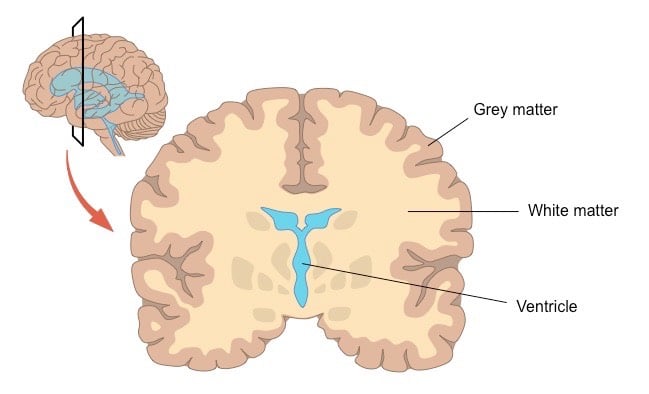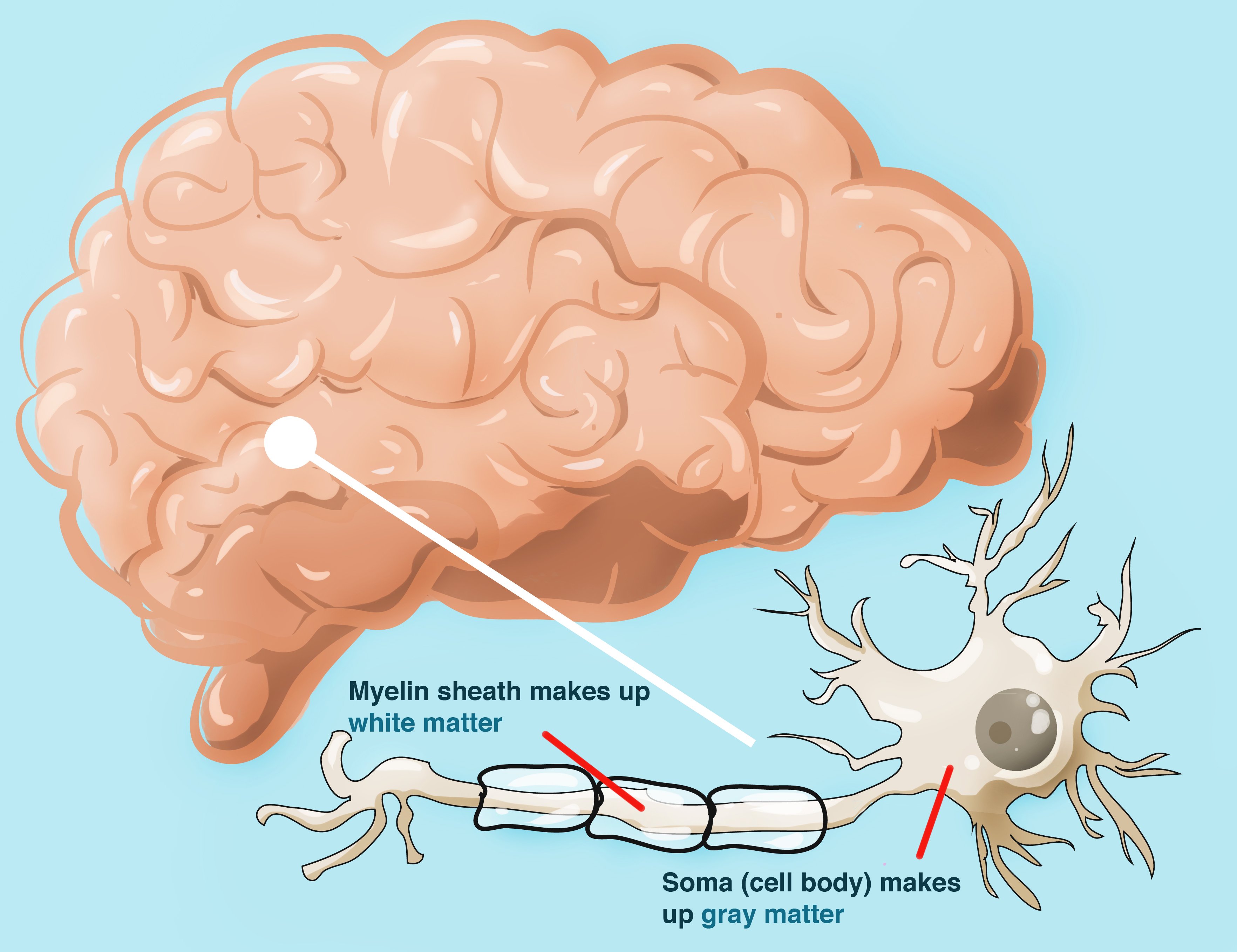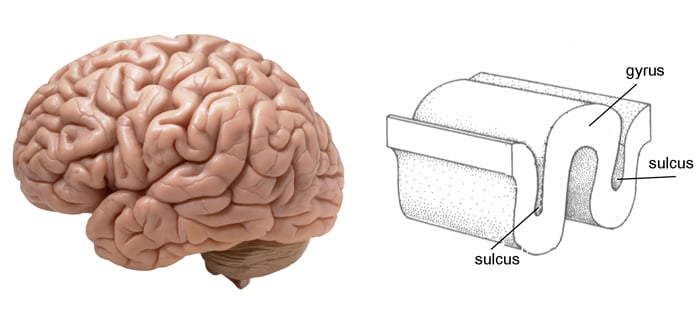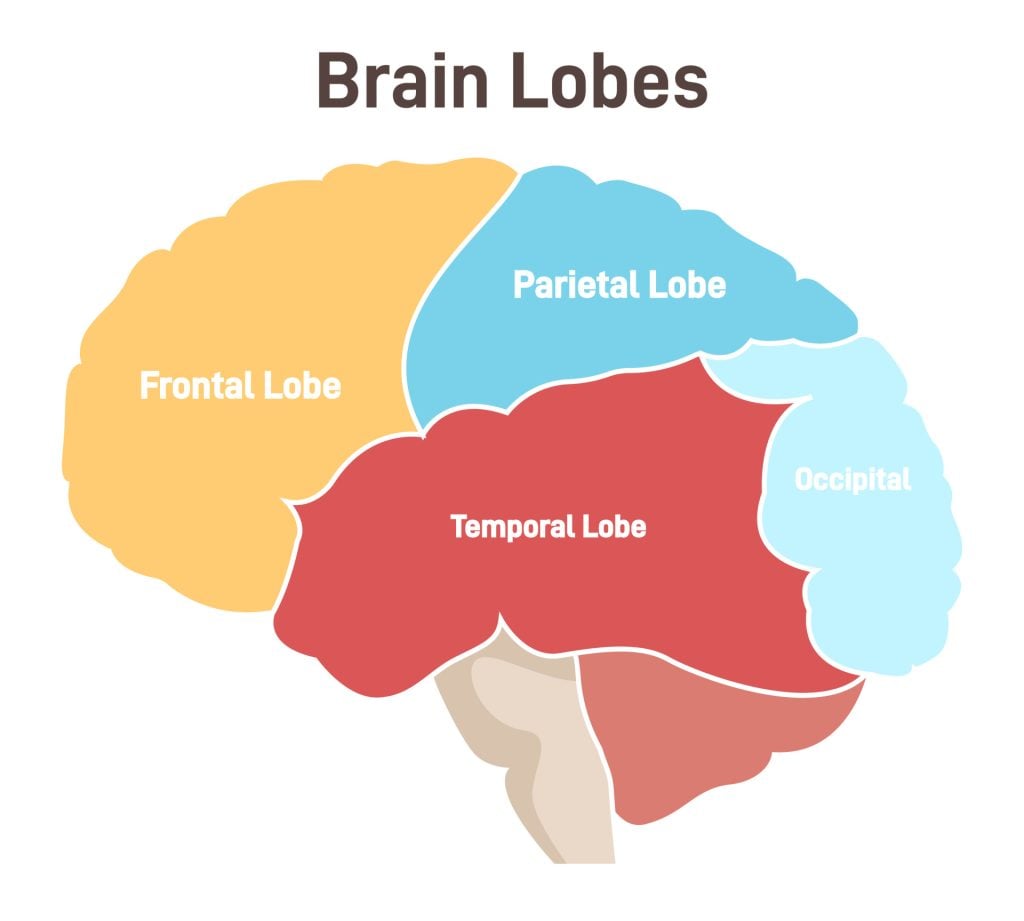On This Page:
The central nervous system is made up of tissue known as grey matter and white matter. Grey matter (or gray matter) makes up the outermost layer of the brain and is pinkish grey in tone, hence the name grey matter.

Gray matter in the brain consists of neuron cell bodies, dendrites, and synapses. It plays a key role in processing information, governing muscle control, sensory perception, and decision-making.
It gets its grey tone from the high concentration of neuronal cell bodies it contains. Grey matter also contains unmyelinated axons. White matter, on the other hand, is mainly composed of long-range myelinated axons, which transmit signals to the grey matter, and only very few neuronal cell bodies.
Grey matter is abundant in the cerebrum, cerebellum, brain stem, and the spinal cord. The sheet of grey matter that constitutes the cerebrum varies in thickness from about 2 to 5mm.
In the cerebellum, which makes up just 10% of the brain’s volume, contains more neuronal cell bodies than the rest of the brain combined. In the spinal cord, grey matter is located in the centre and is shaped like a butterfly if sliced horizontally.
Grey matter plays a significant role in allowing humans to function normally as it allows us to control our movements, retain memories, and regulate our emotions, among many other functions.
Grey matter is, therefore, essential for most aspects of human life. Grey matter is formed in early development from ectoderm. Throughout development, grey matter continues to form until about 8 years old.
After this, grey matter begins to decrease in the areas of the brain, but the density of the matter in particular increases. This increase in density allows for higher processing and further mental development of humans.
What Grey Matter Consists Of
Grey matter consists of neuronal cell bodies (known as soma), which are circular structures that house the nucleus of the cells. In the cerebrum, estimated cell numbers vary from 10 billion to more than 50 billion neurons.
The neurons in the grey matter are connected to other parts of the brain by a layer of nerve fibers called white matter, which lies below the surface of the grey matter.

The grey matter surrounding the cerebrum is known as the cortex of the brain. There are two major cortices of the brain, the cerebral cortex, which contains the lobes (e.g. frontal lobes and parietal lobes), and the cerebellar cortex, which is located at the back and lower part of the brain.
There are also areas of grey matter within the inner sections of the brain, however, these are not known as cortices, but instead called nuclei. On the surface of the cerebral cortex, there are gyri (ridges) and sulci (grooves), which give the cortex its wrinkled appearance.
The purpose of the gyri and sulci is to increase the surface area of the brain. This is crucial for effective functioning as it allows for more neurons to be present in contrast to a smooth brain.

The cortex contains neurons (grey matter), which are interconnected to other brain areas by axons (white matter). The cortex has a folded appearance. A fold is called a gyrus and the valley between is a sulcus.
As well as surrounding the cortices, grey matter extends down and around the brain stem and extends to the spinal cord. Whilst the grey matter of the brain is present in the outermost layer, grey matter is located inside the spinal cord.
Grey matter works in the spinal cord to make signaling more effective. Grey matter also splits into three sections in the spinal cord, these being the anterior grey column, posterior grey column, and the lateral grey column.
Grey matter also contains axons, which are long extensions on cells, branched from the neuronal cell bodies.
These axons are usually unmyelinated, meaning they are not covered by a white-ish fatty protein called myelin. There are also glial cells present in the grey matter, specifically cells called astrocytes and oligodendrocytes.
There are around 10 times as many glial and other cells than there are neurons. The purpose of glial cells is to be supportive to the neurons. They can transport nutrients and energy to the neurons and may even play a role in influencing how well neurons function and communicate to each other.
Function
Grey matter serves to process information in the brain. The structures within the grey matter process signals from the sensory organs or from other areas of the grey matter. This tissue directs sensory stimuli to the neurons in the central nervous system where synapses induce a response to the stimuli.
These signals reach the grey matter through the myelinated axons that make up the bulk of the white matter.
The grey matter that surrounds the cerebrum, also given the name cerebral cortex, is involved in several functions such as being involved in personality, intelligence, motor function, planning, organization, language processing, and processing sensory information.
The cerebral cortex is divided into four lobes based on the gyri and sulci, which help mark these lobes: frontal, parietal, temporal, and occipital lobes.

Specifically, the frontal lobes play functional roles in voluntary behavior such as decision-making, problem-solving, and thinking. Similarly, it is essential for cognition, intelligence, attention, and voluntary motor control.
The parietal lobes have associated functions in perception and the integration of somatosensory information, visuospatial processing, spatial attention, spatial mapping, and number representation.
Temporal lobes are essential for functions such as the comprehension of language, perception through hearing, vision, and smell, recognition, learning and memory.
The occipital lobe’s function is primarily related to vision such as encoding color, orientation, and motion.
Within the cerebral cortex, there are also specific sensory and motor areas.
These include the primary motor cortex and premotor cortex which regulate voluntary movement, the visual cortex of the occipital lobe which processes visual information, and the somatosensory cortex of the parietal lobe which processes tactile information such as touch, pressure, temperature, and pain.
The grey matter in the cerebellum is related to motor control, balance, coordination, and automatic movements. The three sections of grey matter in the spinal cord also serve their functions. The anterior grey column in the spinal cord is important for all motor movements as it connects to the brain through a pathway called the pyramidal tract which originates in the cerebral cortex .
The posterior grey column of the spinal cord plays an important function in receiving sensory signals, allowing for the constant interaction between the environment and the body.
The posterior grey column is located proximate to the surface of the spine which makes it easier for nerves to send signals.
The lateral grey column of the spinal cord, which is found in the middle of the grey matter of the spinal cord, is important for regulating the autonomic nervous system through its role in activating the sympathetic nervous system.
This means it helps to stimulate the body’s involuntary responses to stressful situations such as accelerating heart rate and sending extra blood to the muscles.
Grey Matter Disorders
As grey matter covers many areas of the central nervous system and is the outermost layer to the brain specifically, this makes it susceptible to being damaged.
One of the most prevalent medical problems involving grey matter occurs when there is a plaque build up in one or more areas of the grey matter in the brain.
This plaque takes up the space that would have been where there was once grey matter, meaning there would be a decrease in higher functioning as a result.
If the plaque continues to grow, this can cause a significant decline in cognitive functions and a loss of memory, known as Alzheimer’s disease. Aside from a loss in cognitive functioning, grey matter decline can lead to motor function issues such as losing control of fine motor skills.
The decrease in motor function could contribute to the uncontrollable shaking that is a symptom of Parkinson’s Disease. These diseases that cause a loss of neurons which make up the grey matter are called neurodegenerative diseases.
Trauma to the central nervous system could also play a role in creating issues that stem from grey matter. As the cells in the grey matter require a constant high stream of oxygen to function normally, any trauma such as falling and hitting the head at force could cut off this supply of oxygen.
If there is no oxygen reaching the grey matter, this can cause the cells to die and result in irreversible brain damage and loss of function.
Damage to the cerebral cortex, in general, can result in a variety of symptoms depending on the area which damage occurs.
Damage to the parietal lobe could result in difficulties writing or being unable to write altogether, or an inability to discriminate between sensory information. Damage to the temporal lobes may result in difficulties with comprehending speech, aggression, or memory loss.
Damage to the occipital lobes could result in problems with sight, inability to see colour, or cause hallucinations. Damage to the frontal lobes could result in personality changes, attentional problems, and has been linked to depressive disorders.
Damage to the grey matter of the cerebellum could result in coordination difficulties, issues with balance, and being unable to perform voluntary movements smoothly.
How to Strengthen Grey Matter
For those who have experienced damage to their grey mater, perhaps from trauma, young infants and children often have the better outcomes than adults.
This is because their neural systems are still developing and are more adaptable than adult’s.
Although there may not be any proven treatments for grey matter diseases such as Alzheimer’s and Parkinson’s disease, there are some lifestyle changes that could be adopted to help keep grey matter strengthened and potentially lower the risk of developing neurodegenerative diseases:
- Meditation and mindfulness
- Physical activity, specifically aerobic exercise
- Games which can stimulate problem-solving, attention and creativity
- Maintaining an uninterrupted sleeping pattern
- Eating a healthy diet with plenty of vitamins
- Avoiding alcohol and other mind-altering substances
- Wearing a helmet when completing activities such as cycling so as to avoid damage to the brain
- Hobbies which can train fine motor skills such as calligraphy, knitting, or painting
- Learning new skills or learning new information to stimulate the mind
Interestingly, there have been a growing number of studies which have suggested that electroconvulsive therapy (ECT) may stimulate neuroplastic effects on grey matter.
Specifically, a study by Camilleri et al. (2020) detected grey matter volume increases in the medial temporal lobe after treatment of ECT had finished.
This could be a possible treatment in the future for those who have suffered loss or degeneration of grey matter, but it requires further research.
References
Bailey, R. (2020, February 5). What Does the Brain’s Cerebral Cortex Do? ThoughtCo. https://www.thoughtco.com/anatomy-of-the-brain-cerebral-cortex-373217
Camilleri, J. A., Hoffstaedter, F., Zavorotny, M., Zöllner, R., Wolf, R. C., Thomann, P., Redlich, R., Opel, N., Dannlowski, U., Grozinger, M., Demirakca, T., Sartorius, A., Eickhoff, S. B. & Nickl-Jockschat, T. (2020). Electroconvulsive therapy modulates grey matter increase in a hub of an affect processing network. NeuroImage: Clinical, 25, 102114.
Hydrocephalus Association. (2015, January 29). What’s the Matter? https://www.hydroassoc.org/whats-the-matter/
Mercadante, A. A., & Tadi, P. (2020). Neuroanatomy, Gray Matter.
Robertson, Sally. (2018, August 23). What is Grey Matter?. News-Medical. Retrieved on September 01, 2021 from https://www.news-medical.net/health/What-is-Grey-Matter.aspx.

